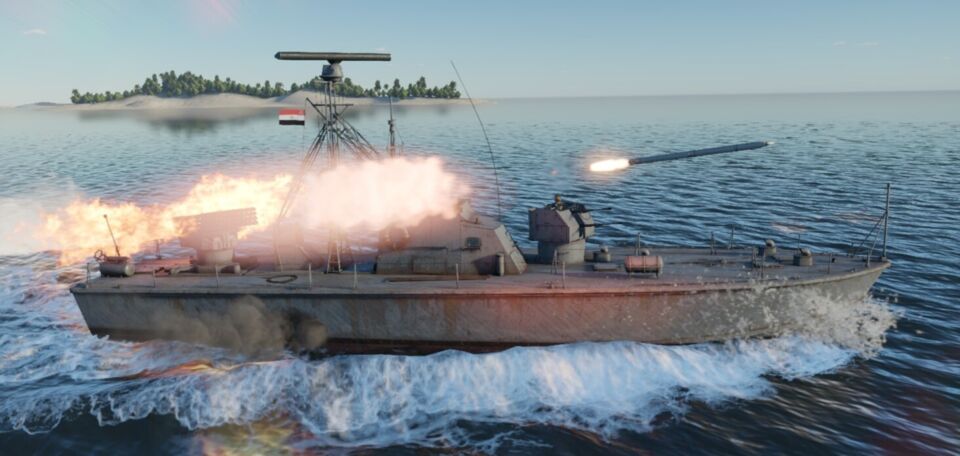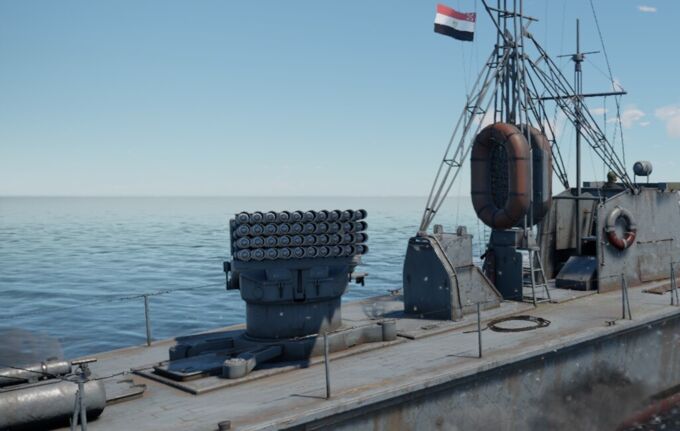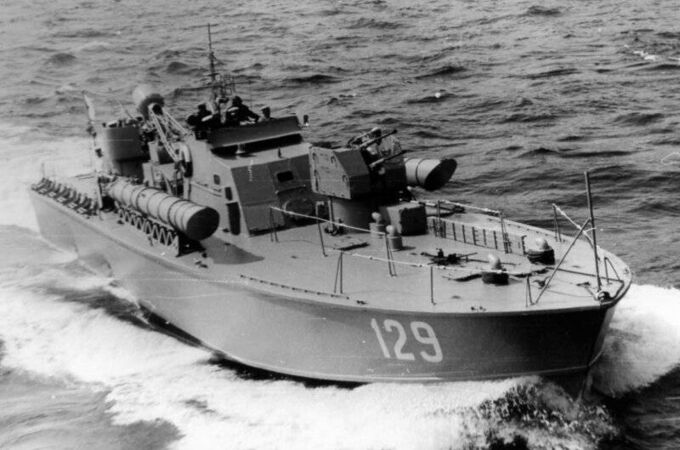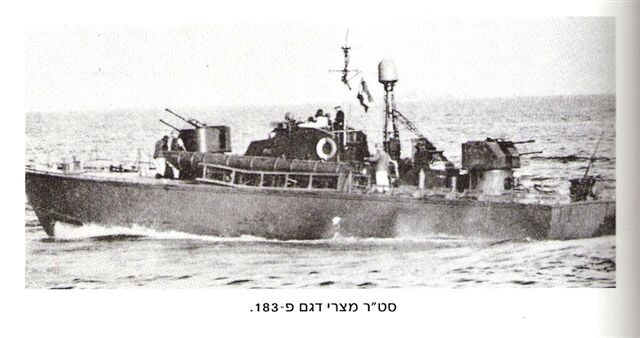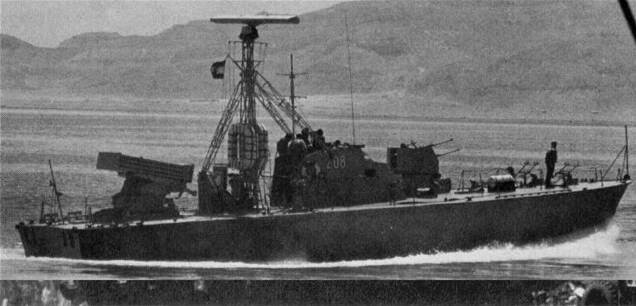The Pr.183 BM-21 is a rare Soviet-designed Egyptian modification that trades torpedoes for rocket artillery. Designed as a fast assault craft, this unique boat merges a WWII-era hull with Cold War firepower, offering devastating burst damage at the cost of poor survivability. She plays nothing like other ships in her tier—if you master the rockets, you’ll devastate enemies. But if you get spotted first, expect a quick trip back to the hangar.
Pros and Cons
| Pros | Cons |
|---|---|
| Powerful 122 mm rockets wreck smaller ships | Poor survivability, wooden hull is not stopping any incoming rounds |
| Excellent ambush and harass potential | Small crew pool |
| Small and nimble for getting into positions quickly | Exposed rocket launcher could trigger a detonation if hit |
Survivability
The Pr.183 BM-21 is extremely vulnerable as the wooden hull offers virtually no protection from enemy fire. A hit from a large-caliber shell is often fatal due to overpressure or shrapnel and it can be destroyed even by small-arms fire. Survivability is also limited by the ammunition storage which is located in the front of the ship right above the waterline. The ship can be vulnerable to beaching in shallow waters, so careful navigation is recommended when sailing near the coast.
Armament
The twin 25 mm
Although this autocannon is the only conventional weapon on board it should not be underestimated as its high fire rate and 55 mm Penetration make it deadly against small craft at close range. However, the 25 mm can only be used when facing forward as the bridge blocks its rear line of fire.
The 25 mm has 3 Belt Options:
- Universal (AP-T/FI-T): Is the most versatile and will be your go-to choice in most situations. It offers a balanced mix of armor-piercing and incendiary rounds, making it effective against both unarmored boats and low-flying aircraft.
- 25 mm AP ( FI-T/FI-T/FI-T/AP-T): Provides superior penetration and is best reserved for engaging heavily armored targets such as steel-hulled patrol boats or gunboats. It’s a good idea to keep a backup AP belt loaded if you anticipate facing tougher enemies.
- 25 mm HE (AP-T/AP-T/AP-T/FI-T): Excels in anti-aircraft defense. It deals more internal damage per hit than Universal, meaning fewer shots need to connect to cripple or destroy enemy aircraft thus making it the most efficient option when fending off air attacks.
122 mm BM-21 Grad MLRS
The 122 mm BM-21 rocket launcher is what gives the ship its name and offensive power. The Grad system can unleash 40 rockets each carrying 10 kg of TNT capable of crippling or outright destroying small and mid-sized ships. Players may need some time getting used to the rocket arc but when mastered these will be the primary tool to score kills. The traverse speed of the launcher is quite slow, so it is recommended to pre-aim before emerging from cover. Additionally, the launcher cannot fire directly forward due to obstruction from the superstructure and bridge.
Mobility
Powered by four engines across four shafts, the Pr.183 BM-21 is agile and capable of quickly repositioning. This makes it ideal for ambushes and quick escapes, especially in confined maps with lots of cover. While it is not as agile as hydrofoil vessels its decent 81 km/h top speed makes it above average among non-foil coastal boats.
Usage in Battles
The Pr.183 BM-21 excels as a fast ambusher and support vessel. Its greatest strength lies in its 122 mm rocket launcher that can obliterate small boats and even inflict serious damage on destroyers. However, as a PT boat it can’t survive prolonged fights or direct engagements. Instead, use your speed to flank early and take up covered positions behind rocks or terrain. From there pre-aim your launcher towards the enemy, peek out briefly, and unleash a burst of 10–15 rockets. Once fired, immediately reverse or relocate to avoid counterfire.
Another viable tactic is to rush a capture point at the start of the match and ambush unsuspecting motor boats with your rockets. Then use your high speed and maneuverability to reposition before heavier ships arrive. The ship is also excellent for hit-and-run engagements, especially on tight maps. Prioritize target selection and careful engagement. Success in the Pr.183 BM-21 comes from clever positioning, surprise and outsmarting the enemy.
History
Development
In the years following the Second World War, the Soviet Union sought to modernize its navy with a focus on fast, inexpensive, and lethal small vessels. The war had shown that small torpedo boats could wreak havoc on larger ships when used smartly in coastal waters. From this experience, Soviet naval designers came up with what would become Project 183, also known by its NATO designation: P-6.
The original Pr.183 torpedo boat, designed in the late 1940s by the Leningrad Central Marine Design Bureau, was a compact, wooden-hulled motor torpedo boat with two 533 mm torpedo tubes, 25 mm autocannons, and radar. Powered by four diesel engines, the boat could reach speeds up to 43 knots and was designed for hit-and-run operations in littoral waters, perfect for defending the coasts of the USSR and its allies.
Its small size, affordability, and versatility made the Pr.183 ideal for export to friendly nations, and soon it became one of the most exported naval vessels of the Cold War era. Over 400 units were produced, and they saw service from Eastern Europe to Southeast Asia.
While the design was well-suited for the 1950s, the rapid development of guided missiles and modern naval guns by the 1960s meant that torpedo boats like the Pr.183 obsolete. Nonetheless, its robust and flexible hull became the foundation for numerous variants, ranging from missile boats and gunboats to, in the Egyptian case a rocket artillery platform.
Egyptian Service
Under President Nasser Egypt sought to modernize its military and protect its shores from Israeli naval attacks. By the early 1960s, Egypt had received 46 Pr.183 boats, primarily for patrol and anti-ship roles.
With the losses of the 1967 Six-Day War, the Egyptian Navy reconsidered how best to use its aging Soviet platforms. With torpedo tactics becoming increasingly risky and outdated, Egypt initiated an unconventional modification: they removed the torpedo tubes and aft turret of several Pr.183s and replaced them with a BM-21 Grad multiple rocket launcher.
This resulted in the Pr.183 BM-21, a new variant built for coastal bombardment and harassment operations. The new vessel was capable of unleashing deadly salvos against enemy positions along shorelines or larger ships in harbors. Its radar and electronics package was also improved to suit its new role.
The Pr.183 BM-21 shares its hull with the Pr.183R Komar-class, another variant of the original Pr.183. The Komar was fitted with P-15 Termit anti-ship missiles and became infamous for carrying out the first anti-ship missile kill in history when it sank the Israeli destroyer INS Eilat on October 21, 1967.
